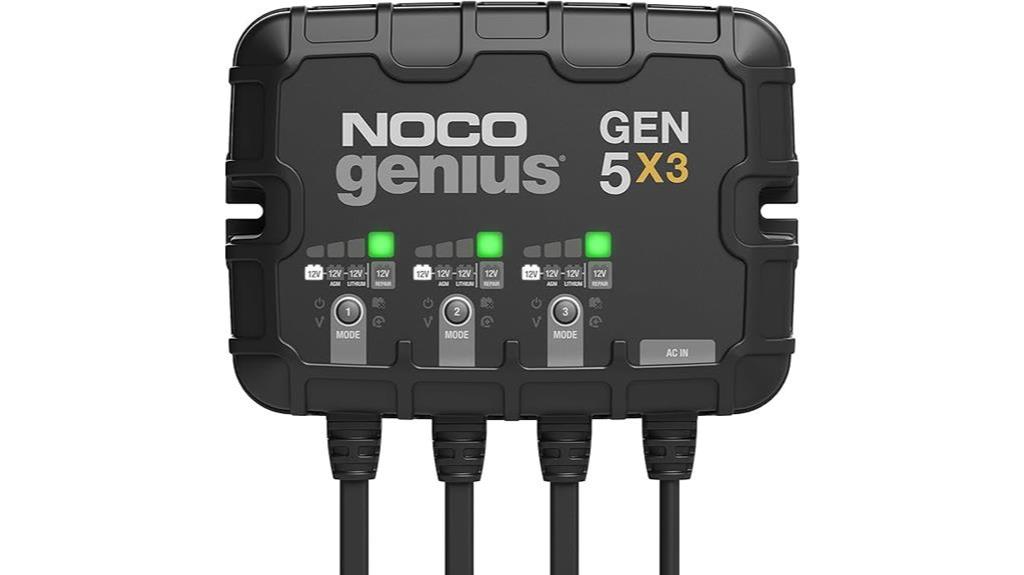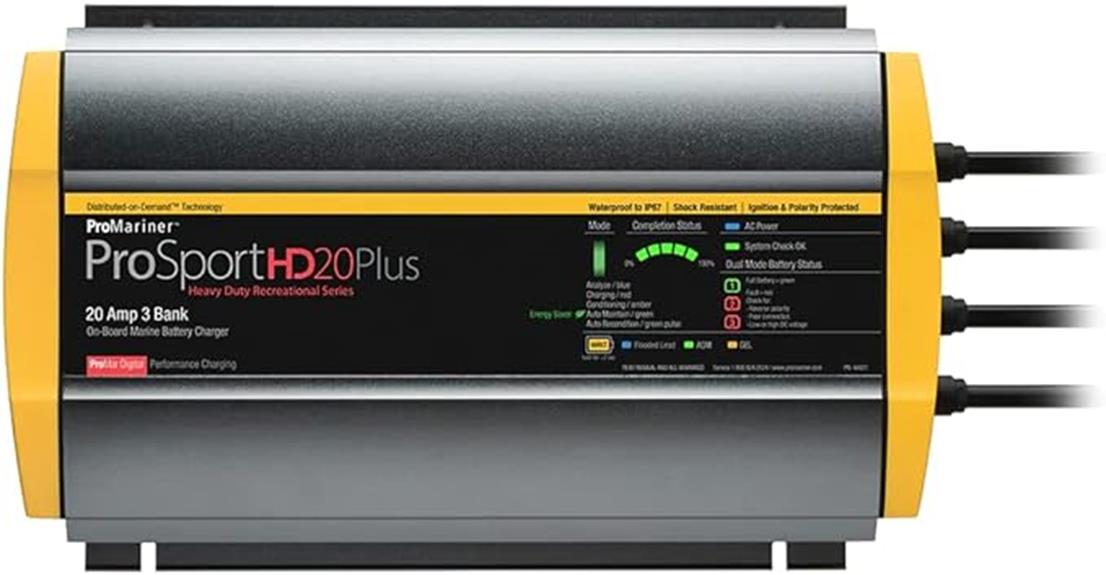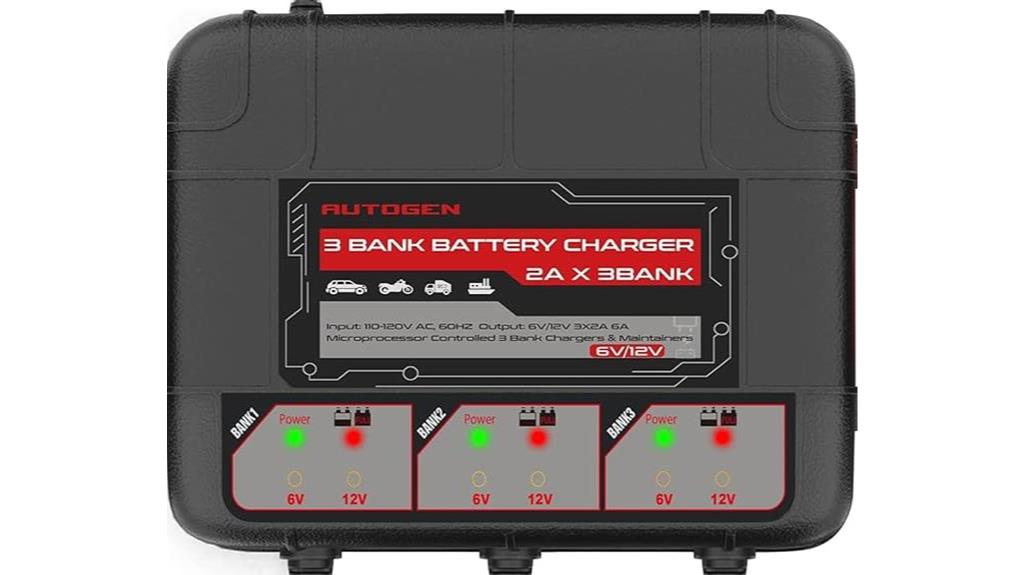If you're looking to power up your marine adventures, you can't go wrong with the top 3-bank battery chargers of 2024. The NOCO Genius GEN5X3 and GENPRO10X3 both offer smart charging features, while the ProMariner ProSport HD delivers impressive performance with advanced digital technology. Johnson Outdoors' MinnKota MK 315D excels in durability, and AUTOGEN provides solid smart technology at a competitive price. Each of these chargers guarantees your batteries are always ready for action, no matter the conditions. Stick around to uncover more details about their features and which one fits your needs best!
NOCO Genius GEN5X3 Smart Marine Battery Charger

If you're a marine enthusiast looking to efficiently charge multiple batteries, the NOCO Genius GEN5X3 Smart Marine Battery Charger is an excellent choice. This compact, three-bank charger delivers 5A per bank, allowing me to charge up to three 12V lead-acid or lithium-ion batteries simultaneously. What I love most is its versatility; it features selectable modes for different battery types and even a repair mode. I appreciate that it can charge batteries as low as 1-volt and maintain them automatically, ensuring they're always ready. The installation is a breeze, thanks to the simplified mounting system and included hardware. Plus, it's fully waterproof and built to last. With a three-year warranty, I feel confident in my investment!
Best For: Marine enthusiasts who need a reliable and efficient solution for charging multiple 12V batteries simultaneously.
Pros:
- Compact design makes it easy to install in various locations without taking up much space.
- Versatile charging modes cater to different battery types, enhancing compatibility.
- Automatic maintenance ensures batteries are kept in optimal condition, ready for use when needed.
Cons:
- May be overkill for users with only one or two batteries, as it is designed for three.
- Initial cost might be higher compared to simpler chargers, impacting budget-conscious buyers.
- The force mode for charging down to zero volts may not be needed for all users, adding complexity.
ProMariner ProSport HD Waterproof Marine Battery Charger (20 Amp, 3 Bank)

The ProMariner ProSport HD Waterproof Marine Battery Charger stands out as an ideal choice for boaters who prioritize reliability and efficiency in their charging systems. With a robust 20 Amp, 3 bank design, it replaces the older Gen 3 ProSport 20 plus model, ensuring you get fast and precise charging thanks to its advanced ProMar Digital Technology. I love that it distributes charging amps as needed, enhancing battery performance and lifespan. The expanded LED display is a real bonus, showing the completion status and battery types at a glance. Weighing in at just 7.2 pounds and built for durability, this charger is compact yet powerful, making it a fantastic investment for any boating enthusiast.
Best For: Boaters seeking a reliable and efficient charging system for multiple batteries.
Pros:
- Fast and precise charging thanks to ProMar Digital Technology and multi-stage charging.
- Durable design with waterproof features and a heavy-duty heat sink for optimal cooling.
- User-friendly display with an expanded LED status bar that shows battery completion and status.
Cons:
- Some users reported issues with warranty claims and product defects.
- A few customers experienced water damage that voided their warranty.
- Some feedback indicated slower customer service during high-demand periods.
NOCO Genius GENPRO10X3 Smart Marine Battery Charger

For anyone looking to efficiently manage multiple batteries on their boat or RV, the NOCO Genius GENPRO10X3 Smart Marine Battery Charger stands out with its ability to independently charge three 12V batteries at 10 amps each. This charger caters to various battery types, including lead-acid and lithium-ion, making it incredibly versatile. I love the built-in thermal sensor that adjusts the charge based on the temperature, ensuring peak performance. Plus, it can revive batteries as low as 1 volt, which is a game-changer for those unexpected dead battery situations. With its waterproof design and simplified installation, I found it easy to set up in any position. Overall, it's a reliable choice that delivers great performance and peace of mind on the water.
Best For: Those seeking a reliable and versatile battery charger for multiple 12V batteries on boats or RVs.
Pros:
- Independently charges three batteries at 10 amps each, accommodating various battery types.
- Built-in thermal sensor optimizes charging based on ambient temperature to prevent over/under-charging.
- Waterproof design with an IP68 rating ensures durability in harsh marine environments.
Cons:
- Limited to 12V batteries, which may not suit users with different voltage requirements.
- Installation may require some technical knowledge for optimal setup in certain configurations.
- Higher initial cost compared to basic chargers, which might deter budget-conscious buyers.
Johnson Outdoors MinnKota MK 315D On-Board Battery Charger (3 Banks, 5 Amps per Bank)

Looking for a reliable charger for your 24-volt trolling motor setup? The Johnson Outdoors MinnKota MK 315D On-Board Battery Charger is an excellent choice. With three banks and five amps per bank, it efficiently charges two 12-volt batteries for your motor and one for your starting needs. I love its multi-stage charging and automatic temperature compensation, ensuring my batteries get the care they need. Plus, it's saltwater tested and corrosion-resistant, making it durable for any marine environment. The status lights are a handy feature, letting me know when my batteries are charging, fully charged, or if there's a problem. With a three-year warranty and solid customer support, I feel confident in my investment.
Best For: The Johnson Outdoors MinnKota MK 315D On-Board Battery Charger is best for boaters needing a reliable and efficient charging solution for their 24-volt trolling motor setups.
Pros:
- Multi-stage charging ensures optimal battery care and longevity.
- Saltwater tested and corrosion-resistant design makes it suitable for harsh marine environments.
- Three-year warranty and responsive customer support provide peace of mind for users.
Cons:
- The charger is larger and heavier than some users may expect.
- Some users report issues with blown fuses, although warranty coverage helps mitigate concerns.
- Initial setup may require a bit of technical knowledge for proper installation.
AUTOGEN 3-Bank Marine Battery Charger

When you need a reliable charger for multiple marine batteries, the AUTOGEN 3-Bank Marine Battery Charger stands out with its smart technology that independently charges and maintains up to three batteries. With a 6-amp output, it delivers 2 amps per bank, making it compatible with both 6V and 12V lead-acid batteries, including wet, gel, AGM, and deep-cycle types. The automatic voltage detection guarantees ideal charging conditions, while the two-color LED light keeps you informed about the charge state. Plus, it features multiple safety protections to prevent overcharging and overheating. Although customer reviews are mixed, many appreciate its ability to maintain battery life effectively. With a waterproof design, it's ready for any adventure on the water!
Best For: boating enthusiasts and owners of multiple marine vehicles seeking a dependable and efficient battery maintenance solution.
Pros:
- Multiple Battery Charging: Independently charges and maintains up to three batteries simultaneously.
- Smart Technology: Features automatic voltage detection and safety protections to prevent overcharging and overheating.
- Durable Design: Waterproof (IP65) construction makes it suitable for use in marine environments.
Cons:
- Mixed Customer Reviews: Some users report concerns about performance and long-term durability.
- Water Ingress Issues: A few reviews mention potential issues with water ingress despite the waterproof rating.
- Limited Output: With only 2 amps per bank, it may charge larger batteries more slowly compared to higher-output chargers.
Factors to Consider When Choosing 3-Bank Marine Battery Chargers
When you're choosing a 3-bank marine battery charger, it's essential to take into account several key factors. You'll want to think about the charging power and capacity, battery compatibility options, and how easy it is to install and mount. Additionally, don't overlook safety features and the overall design and durability of the charger.
Charging Power and Capacity
Choosing the right charging power and capacity for your 3-bank marine battery charger is vital, especially if you rely on your boat or RV for high-demand activities. Start by considering the total charging capacity, typically measured in amps. Most chargers range from 5A per bank to 10A or more. A higher amperage allows for faster charging of multiple batteries simultaneously, which is fundamental for keeping your systems powered.
Look for chargers that employ multi-stage charging technology. This feature enhances battery performance by adjusting the charge based on the battery's current state and condition, ultimately extending battery life. Additionally, you'll want to make sure that your charger can handle low voltage situations—some can charge batteries as low as 1 volt or even zero volts. This capability is invaluable for recovering deeply discharged batteries and maintaining them effectively.
Battery Compatibility Options
Battery compatibility plays a key role in selecting the right 3-bank marine battery charger. You need to guarantee that the charger you choose can handle various battery types, including 12V lead-acid options like flooded, gel, AGM, and deep-cycle batteries, as well as lithium-ion batteries (LiFePO4). This versatility is essential, especially if you plan to use different batteries for your boat or RV.
Look for chargers that can charge multiple battery types simultaneously, providing flexibility for your adventures. It's also wise to take into account models that can kickstart charging at low voltage levels, with some capable of initiating charge at only 1 volt or even zero volts. This feature can be a lifesaver if your batteries have been sitting unused for a while.
Additionally, chargers with selectable modes for specific battery types, like dedicated settings for AGM or lithium, will help optimize charging efficiency and extend battery life. Automatic voltage detection can further enhance usability, allowing the charger to adapt to both 6V and 12V batteries without requiring manual adjustments. Make sure to evaluate these compatibility options when choosing your charger to guarantee you're making the best investment for your power needs.
Installation and Mounting Ease
Installing a 3-bank marine battery charger can be straightforward if you consider a few key factors. First, look for chargers with simplified mounting systems. These allow you to install the unit in any orientation, even upside-down, making it easier to fit into various spaces on your boat.
Next, verify the charger comes with self-tapping screws and clear user guides. This feature minimizes the need for additional tools and helps you get the charger up and running quickly.
Also, consider models with integrated anti-vibration backing. This design not only isolates shock but also reduces noise during operation, enhancing both durability and your overall experience.
Evaluate the length of the DC cables provided as well. Longer cables, like those around 72 inches, can make installation easier, especially in larger vessels or areas with limited access.
Safety Features and Protections
When it comes to guaranteeing the longevity and performance of your marine batteries, safety features and protections are non-negotiable. Look for chargers that include essential protections like overcurrent, overcharge, overheat, reverse connection, and short circuit. These features will safeguard your batteries from potential damage during charging.
A waterproof rating, such as IP68 or IP65, indicates that the charger can endure harsh marine environments, enhancing its reliability. You'll also want a charger with integrated thermal sensors, which help prevent overheating by adjusting the charging process based on ambient temperature. This capability is vital for maintaining battery health.
Additionally, consider chargers that utilize multi-stage charging technology. This approach not only optimizes battery performance but also extends battery life by minimizing overcharging risks. Finally, a continuous charging mode that shifts automatically to maintenance mode after a full charge guarantees your batteries stay ready for use without the danger of overcharging.
Design and Durability
Choosing the right 3-bank marine battery charger involves considering both design and durability to guarantee it withstands the rigors of marine life. Look for chargers with a waterproof rating, like IP68 or IP65, to protect against water damage in harsh environments. A compact and lightweight design enhances portability and simplifies installation, making it easier to fit into tight spaces on your boat or RV.
Anti-vibration features are essential, as they help isolate the charger from shocks and vibrations, extending its lifespan considerably. Additionally, consider chargers with a simplified mounting system, allowing for installation in any orientation. This versatility can be a game-changer when you're limited on space.
Heavy-duty heat sink designs are another key factor; they improve cooling during the charging process, reducing the risk of overheating. By prioritizing these design aspects, you're not just investing in a charger; you're ensuring reliable performance and longevity. A robust charger will keep your batteries powered and ready for all your marine adventures, allowing you to focus on enjoying the great outdoors without worrying about your equipment.
Warranty and Support Services
Warranty and support services play an essential role in your decision-making process for selecting a 3-bank marine battery charger. When you're investing in this significant equipment, consider the length and coverage of the warranty. Many products offer a standard three-year warranty, which can provide you with peace of mind during your adventures.
It's also important to look for customer support responsiveness. Effective support can assist you with warranty claims and any product issues that may arise. You should evaluate the manufacturer's reputation for honoring warranty claims. Customer feedback can reveal how well claims are processed and resolved, guaranteeing you're backed by a reliable company.
Don't forget to check the return policies. A solid return policy, such as a 30-day satisfaction guarantee, means you can return the product if it doesn't meet your expectations. Finally, verify that the charger complies with safety certifications, as this can impact warranty validity and support in case of product failure. By considering these factors, you'll feel more confident in your choice and ready to hit the water without worry.
Monitoring and Maintenance Features
Considering the importance of keeping your batteries in ideal condition, monitoring and maintenance features are essential in selecting a 3-bank marine battery charger. Look for chargers equipped with LED indicators that give you real-time updates on the charging status. These indicators let you know if your batteries are charging, in trickle mode, or fully charged—making it easier to manage your power effectively.
Advanced options offer automatic voltage detection, adapting to different battery types for maximum performance. This guarantees that your batteries receive the appropriate charge, helping maintain their health over time. Some models use solid-state technology to monitor charge levels continuously, automatically entering maintenance mode once the batteries are full, which can greatly extend their lifespan.
Don't overlook safety features, either. Protect your investment with chargers that include safeguards against overcurrent, overcharge, overheating, reverse connections, and short circuits. Continuous charging capabilities are also beneficial, allowing you to keep the charger plugged in indefinitely without the risk of overcharging. By prioritizing these monitoring and maintenance features, you'll make sure your batteries stay in peak condition for your next adventure.
Frequently Asked Questions
How Do I Install a 3-Bank Marine Battery Charger?
To install a 3-bank marine battery charger, start by positioning the charger in a dry, ventilated area near your batteries. Connect the positive terminals of all three banks to their respective batteries, and then link the negative terminals. Make sure to use appropriate gauge wires. Once connected, mount the charger securely and plug it into a power source. Finally, double-check all connections for safety before powering it on. You're ready to go!
Can I Use These Chargers for Other Battery Types?
Picture yourself on the open water, your boat humming with energy. You might wonder if those 3-bank marine battery chargers can handle other battery types. The answer's yes, in many cases! These chargers often work with different lead-acid batteries, but check compatibility first. Just remember, using them with lithium or gel batteries might require special settings. So, before you plug in, make sure your charger matches the battery type to power your adventures safely.
What Maintenance Is Required for Marine Battery Chargers?
To keep your marine battery charger in top shape, you'll want to regularly check the connections for corrosion and guarantee they're tight. Clean the charger's exterior to prevent dirt buildup, which can affect performance. Also, inspect the charging cables for any wear or damage. It's a good idea to test the charger periodically to verify it's functioning properly. Finally, store it in a dry, cool place when not in use to prolong its life.
How Long Does It Take to Fully Charge Batteries?
Charging time for batteries depends on several factors, like their size and state of charge. Typically, it can take anywhere from a few hours to overnight. If you're using a high-quality charger, it'll often charge faster. Always check the manufacturer's specifications for your specific batteries, as some might need more time due to their capacity or age. Regularly monitoring your batteries can help you gauge how long it takes to fully recharge them.
Are These Chargers Safe for Overnight Use?
You might be wondering if it's safe to leave your marine battery charger on overnight. Fortunately, most quality chargers are designed with safety features that prevent overcharging and overheating, allowing you to charge your batteries without worry. Just make sure you choose a model with built-in protections, like temperature sensors and automatic shut-off. By doing this, you can rest easy knowing your batteries are charging safely while you enjoy a good night's sleep.
Wrapping Up
In your quest for the perfect 3-bank marine battery charger, remember that the right choice can be the heartbeat of your adventures on the water. Each option we've explored brings unique strengths to the table, ensuring your batteries are always ready to go. So, whether you're cruising the coast or fishing in a quiet cove, invest wisely and power up your journey. After all, a well-charged battery is like a steady compass—it keeps you on course.
